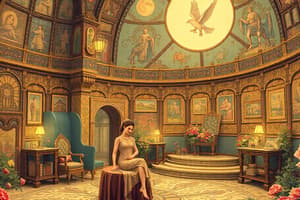Podcast
Questions and Answers
What literary device involves the repetition of words in reverse order?
What literary device involves the repetition of words in reverse order?
- Chiasmus (correct)
- Juxtaposition
- Anaphora
- Parallelism
Which of the following best describes a pun?
Which of the following best describes a pun?
- A serious critique using humor.
- An exaggerated statement for effect.
- An indirect reference to a well-known story.
- A humorous play on words. (correct)
What is the primary function of pathos in rhetoric?
What is the primary function of pathos in rhetoric?
- To evoke an emotional response. (correct)
- To create humor through satire.
- To present contrasting ideas clearly.
- To appeal to logic and reason.
Which term refers to a direct comparison using 'like' or 'as'?
Which term refers to a direct comparison using 'like' or 'as'?
What is meant by the term 'juxtaposition' in literature?
What is meant by the term 'juxtaposition' in literature?
Flashcards
Anaphora
Anaphora
Repetition of words/phrases at the beginning of clauses or sentences.
Chiasmus
Chiasmus
Balance clauses with reversed structure for contrast.
Irony
Irony
Contrast between appearance and reality.
Juxtaposition
Juxtaposition
Signup and view all the flashcards
Metaphor
Metaphor
Signup and view all the flashcards
Study Notes
Literary Devices and Techniques
- Anaphora: A rhetorical device involving the repetition of words or phrases at the beginning of consecutive clauses or sentences for emphasis.
- Chiasmus: A figure of speech where two or more clauses are balanced against each other by the reversal of their structures (e.g., "Ask not what your country can do for you, ask what you can do for your country").
- Irony: A contrast between appearance and reality, often highlighting an unexpected outcome or contradiction.
- Juxtaposition: Placing two elements close together to emphasize their differences or contrasting qualities.
- Metaphor: A figure of speech that makes an implicit comparison between two unrelated things, suggesting they are alike in a significant way.
Rhetorical Strategies
- Qualify: Adding conditions or limitations to an agreement to present a more nuanced view.
- Parallelism: A structure that uses similar grammatical constructions for clarity and balance in sentences.
- Paradox: A statement that appears contradictory or absurd but may reveal a truth upon closer examination.
- Connotation: The implied or associated meanings of a word beyond its literal definition, influencing the emotional response of the audience.
- Anecdote: A brief, engaging story or account that illustrates a point, often humorous or relatable.
Comparisons and Wordplay
- Simile: A comparison between two different things using "like" or "as" to create vivid imagery.
- Pun: A humorous play on words that exploits multiple meanings or similar-sounding words for comedic effect.
- Oxymoron: A figure of speech in which contradictory terms appear in conjunction, enhancing the complexity of a description.
- Parody: A satirical imitation of a particular genre, style, or work that exaggerates for comedic effect.
Appeals and Arguments
- Pathos: An emotional appeal that seeks to elicit feelings of sympathy or compassion.
- Polysyndeton: The use of several conjunctions in close succession for emphasis, creating a feeling of abundance or overwhelm.
- Hyperbole: Deliberate exaggeration used for emphasis or effect, often humorous.
- Logos: An appeal to logic and reasoning, using facts and evidence to persuade.
- Ethos: An appeal to credibility or character, establishing trustworthiness of the speaker or source.
Structure and Meaning
- Antithesis: The juxtaposition of contrasting ideas or phrases within a parallel structure, highlighting differences.
- Asyndeton: The omission of conjunctions between clauses for a more rapid or dramatic effect.
- Diction: Selection of words, reflecting the tone and style of the writing, and influencing the reader’s perception.
- Denotation: The literal dictionary definition of a word, in contrast to its connotation.
- Syntax: The arrangement of words and phrases to create well-formed sentences in a language.
Sound Devices and References
- Alliteration: The repetition of initial consonant sounds in closely placed words, often used for rhythm and emphasis.
- Allusion: An indirect reference to a person, event, or piece of literature that enriches comprehension through context.
- Analogy: A comparison drawn between two different things that share some common characteristics, used to clarify or explain.
- Satire: A critical and humorous portrayal of societal issues, often aiming for reform by highlighting absurdities.
- Archetype: A typical example or universal symbol that represents a broader concept across cultures and genres.
- Euphemism: A mild or indirect word or expression substituted for one considered too harsh or blunt.
Studying That Suits You
Use AI to generate personalized quizzes and flashcards to suit your learning preferences.




